(Update II – December 18, 2023: This year, I received an interesting message from P-38 historian John Clements. Specifically: “I stumbled on your websites the other day doing a semi-regular troll for P-38 information on the web. I am working on a book on the P-38, trying to present the most accurate information possible. I was stunned when I came across the two photos of Milton Joel standing in front of a P-38D during the Carolina Maneuvers in the articles from 2020. #96 has all of the characteristics of a YP-38, not a P-38D. It could also be a straight P-38, but I have never seen any model of the early aircraft with a YP-38 style lower cowling.”
Upon receiving John’s message, I consulted Volume I of Bert Kinzey’s two-part series on the P-38 – specifically, the set of 1/72 line drawings of the YP-38 on pages 23 through 25 – and immediately verified John’s observation: In YP-38s, the oil cooler inlets are less circular than those of the D version, featuring a vertical double-divider in the center. This is entirely consistent with the appearance of the inlets of the aircraft behind Major Joel. As related by John, “I haven’t found evidence of any kind that this style was on any other model. I’m including another photo of the YP that was used in wind tunnel tests in Virginia. It’s the best photo of the engine nacelle of the YP’s that I have found so far.”
Thanks, John! More information and photos appear below…!)
(Update I – January 13, 2021: Originally created on November 12, 2020, this post has been updated to include three new images. These comprise a portrait of Milton Joel standing before a Stearman PT-17, taken while be was in Primary pilot training, and, two images from the U.S. School Yearbook database at Ancestry.com. The latter are specifically from the 1940 Yearbook for the University of Richmond, Milton Joel’s alma mater. These two images comprise a group photo of the University of Richmond Aviation Club, and, Milton’s graduation portrait. Scroll on down to take a look…)
________________________________________
Part II: From Proskurov to Richmond
Let’s start at a man’s beginning…
Milton Joel was born in Richmond, Virginia, on July 12, 1919, to Joseph and Minnie (Weinstein) Joel. Characterized as a “change of life baby” due to his parents’ then relatively advanced ages (in the context of that era) of 38 and 32, respectively, he would be their only child.
Joseph, described by Sara F, Markham (the best friend of Milton’s (eventual!) wife Elaine Ebenstein) as, “…a Judaica scholar and a homespun philosopher who was always writings letters to the Op-Ed page of our reactionary gazette, the Richmond Times-Dispatch,” owned and operated the Virginia Jewelry Store, following – to a minor extent – the footsteps of his own father, Salomon.
________________________________________
Fortunately; remarkably, Joseph’s literary and historical bent led him, towards the end of his life in 1960, to compose – with Myron Berman (then rabbi of Temple Beth-El in Richmond) – an essay covering his family’s genealogy and history. This appeared in the July 1979, issue of The Virginia Magazine of History and Biography, under the title “My Recollections and Experiences of Richmond, Virginia, 1884-1892.”
Though focused on his father, Joseph’s essay enables us to place Milton’s life in a deeper, multi-generational historical context.
The introduction to the essay (there’s far more to it!) follows below. (References to the Ukrainian SSR should be understood in terms of the essay’s 1979 publication.)
THESE memoirs constitute a small portion of the autobiographical manuscripts written by Joseph Joel (1882-1960) near the end of his life. They display a panorama of Jewish civilization at the turn of the century as well as the reflections of an East European immigrant upon life in Europe America. The narrative, which focuses mainly upon the experiences Joseph Joel’s father, Salomon Czaczkes (Joel) (1853-1934), constitutes both the epitome and antithesis of an immigrant’s odyssey from Galicia in the Austro-Hungarian empire to America in the period immediately prior to World War I. What is perhaps unique about Salomon Joel’s peregrinations is that unlike the majority of his East European compatriots whose transatlantic passages were paid by prosperous relatives from America, Salomon Joel and his family eventually returned to Europe on a prepaid ticket provided by the European branch of his family. (1)
Brought to these shores while yet an infant, Joseph Joel years later pieced together the poignant details of his parents’ migration from Proskurov, originally part of Poland but through annexation in the eighteenth century incorporated into the Russian empire. (2) Because Salomon Joel had lived within the borders of Galicia, he was looked upon with suspicion by the Russian government. With ten growing children to provide for, Salomon’s father earlier had decided to move from Tarnopol (3) to Podwoloczyska (4) as the railroad had been extended to that border outpost between Russia Austria-Hungary and afforded economic advantages for merchants dealing in agricultural products.
When his mother died, Salomon Joel was subject to the vagaries of his stepmother. It was she who was responsible for his enrollment in a yeshiva or Jewish parochial school away from home and for his early marital alliance with a cousin of hers in Proskurov. (5) Eventually he was himself the father of ten children, three of whom, including Joseph, were born in Europe. The untenability of his legal status, the precarious nature of his livelihood, and, finally, the pull of a brother and a sister already residing in America were primary factors motivating the emigration of Salomon Joel with his family. (6)
Joel had a difficult time adjusting to the American economy. Although he had been a grain merchant in Europe, he opened a jewelry store in Richmond, which proved a fiasco. Never having learned the business, he was always dependent upon the services of trained technicians whom he had to employ. Devoting himself more to communal pursuits than to his livelihood, Joel moved frequently within the city of Richmond and finally to Chicago to try his luck during the World’s Fair of 1893. When economic conditions in the United States worsened shortly thereafter, Salomon Joel returned with his family to Podwoloczyska.
In Europe, Joel was assisted by his stepbrother but never fared well. He typified a large segment of immigrants who could not adjust to the American environment and to a certain extent may be categorized as Luftmenschen, trying to subsist on air. Salomon Joel died in Europe, and tragically a large number of his family were later massacred by the Nazis. (7)
Joseph Joel, however, returned to America in 1914 and, after a brief sojourn in Deming, New Mexico, became a jewelry merchant in Richmond. More successful than his father, he wrote nostalgically about the good old days of strong religious and family ties, which contrasted rather starkly with the environment of the ‘fifties. Joseph married Minnie Weinstein, the daughter of a Landtsmann or compatriot from Tarnopol, whose family’s voyage to America had been facilitated by Salomon Joel. Their only son, Captain [sic] Milton Joel, was killed during World War II. In later years, Joseph Joel, despite certain eccentricities, became a patriarch to his family.
1) Joseph Czaczkes, a banker, Salomon Joel’s stepbrother, was the family’s benefactor.
2) Proskurov today is in the Ukrainian Soviet Socialist Republic. The population of the city was forty percent Jewish until World War II when it was occupied by the Germans.
3) Tarnopol, Galicia, today is called Ternopol and is in the Ukrainian SSR.
4) Podwoloczyska, Galicia, is called Podvolochisk and is in the Ukrainian SSR.
5) Salomon Josel first married Yetta Bernstein and upon her death, her sister Bertha.
6) The children of Salomon Joel were as follows:
Fannie (1873-1891), buried at the Sir Moses Montefiore Cemetery in Richmond
Moses (1877-1904), buried in Podwoloczyska
Yetta died in infancy and was buried in Podwoloczyska
Joseph (1882-1960), buried at Beth Ahabah’s Hebrew Cemetery in Richmond
Israel (1886-1930), buried in Wiener Neustadt
Esther (1980-ca.-1940), exterminated by the Nazis
Herman (1890-1965), buried at Sir Moses Montefiore Cemetery
Efraim (1893-1977), buried at Sir Moses Montefiore Cemetery
Mushke or Moses (1904-1930), buried at Sir Moses Montefiore Cemetery
Robert (1898 – ), a resident of Miami
and Clara (1912 – ), a physician in Baltimore
(7) Members of his family from America visited him just prior to his death in 1934.
________________________________________
But how did “Czaczkes” become “Joel”?
As noted elsewhere in the essay, Joseph’s, “…father [was] Salomon Czaczkes, who changed his name on arrival at Richmond, Va. to Salomon Joel. This changing of name was due to the fact that there were few foreigners here and the people just couldn’t pronounce the “Cz” as “Ch” as in Chicken,” etc.”
________________________________________
A 1930s view of the Joel family home in Richmond. (c/o Harold Winston)
 This Oogle Street View shows that the now-nearly-century-old residence (it was constructed in 1922) looks much the same today.
This Oogle Street View shows that the now-nearly-century-old residence (it was constructed in 1922) looks much the same today.
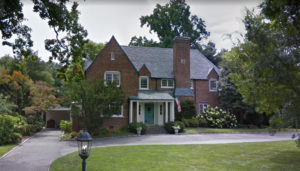 Milton’s bar mitzvah portrait. (c/o Harold Winston)
Milton’s bar mitzvah portrait. (c/o Harold Winston)
 Though I don’t know the date of his bar mitzvah, Milton’s birth on Saturday, July 12, 1919, may (may…) have correlated to a Bar Mitzvah date of July 18, 1932 (Tammuz 14, 5692). If so, his Haftorah would have been Parshat Pinchas, concerning which there is a vast amount of commentary, such as these examples from…
Though I don’t know the date of his bar mitzvah, Milton’s birth on Saturday, July 12, 1919, may (may…) have correlated to a Bar Mitzvah date of July 18, 1932 (Tammuz 14, 5692). If so, his Haftorah would have been Parshat Pinchas, concerning which there is a vast amount of commentary, such as these examples from…
The late Rabbi Jonathan Sacks (z”l)
Wikipedia (well, inevitably Wikipedia!)
Though, unsurprisingly, there’s little information about Milton’s childhood and adolescence, it is known that he graduated in 1936 from Thomas Jefferson High School in Richmond. There, he was active in the school’s newspaper, aptly titled The Jeffersonian, as reported in Richmond Times-Dispatch article of February 16, 1936.
–
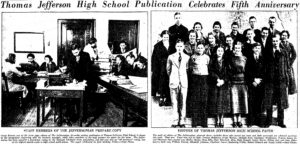 In the photo, Milton is among the group of students in the right-hand image, where he stands second from right in the second row.
In the photo, Milton is among the group of students in the right-hand image, where he stands second from right in the second row.
Caption: “The staff of editors of The Jeffersonian, pictured above, includes those who served last term and their successors for editorial positions this term. They are: Front row, left to right, Norman Robinson, Grant Morton, Adelaide Rose, Constance Strailmann, Watson James, Jr., and Thurman Day. Second row, Shirley Sheain, Rosa Ellis, Mary Elizabeth Alvis, Ruth Keppel, James Harris, Milton Joel and Jane Obermeyer. Back row, William Franch, Elizabeth Johnson, Charlotte Nance, Kathering Priddy, Robert Howard and Austin Gribb.”
________________________________________
Milton’s father Joseph, at the family home in the 1930s or 40s. (c/o Harold Winston)
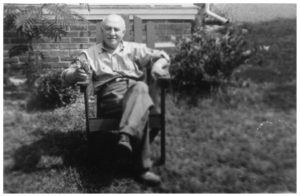 ________________________________________
________________________________________
Though the source of his aeronautical inspiration is unknown, Milton’s interest in flying was apparent by the time he attended the University of Richmond (he first attended the University of Virginia), his enrollment commencing in 1936. There, he participated in a pilot training program sponsored by the CAA (Civil Aeronautics Authority; later the Civil Aeronautics Board), which was covered in the following three Richmond Times-Dispatch news items.
____________________
 Students Are Taught to Use Parachutes – – – on the Ground
Students Are Taught to Use Parachutes – – – on the Ground
Richmond Times-Dispatch
December 19, 1939
University of Richmond flying students received their first instruction in parachute jumping yesterday, but, to the relief of many, the training was given on the ground.
Instructor J.H. Preissner pointed out the correct method of opening the ‘chute and delved into technical details for the benefit of the class of 17 students at Byrd Airport.
The group has been receiving the flight instruction, sponsored by the Civil Aeronautics Authority, since October 18, in two classes of two hours’ duration each week. The course, consisting of 72 hours of class work, will be completed in June.
10 Are Active Pupils
Prior to the beginning of actual flying instruction 10 days ago, the students were taught civil air regulations and aerodynamics. Ten member of the class are active pupils while the others are alternates.
Examinations will be given by the Federal Government. The training is being given the students by the Government at approximately one-tenth what would be charged at private fields in order to raise the number of civilian pilots in the United States.
The students are in no way obligated to the Government, however, it was pointed out. In all probability an advanced course will be given next year.
Caption: COLLEGE PUPILS STUDY ‘CHUTES – University of Richmond students who are taking a flying course under the Civil Aeronautics Authority, got their first instructions yesterday in taking to the air via a parachute. Members of the class are shown above with Instructor J.H. Preissner. Left to right, are Milton Joel, Parke Starke, Harvey Chapman, Ernest Taylor, Clyde Ford, Donald Murrill, Mr. Preissner, Samuel George, Thomas Bruno and Tom Wiley.
____________________
In this Richmond Times-Dispatch news article of February 28, 1940, covering CAA pilot training of University of Richmond Students, Milton stands at the far right. (c/o Congregation Beth Ahabah Archives)
A nearly similar image – below – appeared in the University of Richmond 1940 yearbook, which specifies that the fourteen men in the photo are actually members or associates of the University of Richmond Aviation Club.
A close inspection reveals that these are actually two different photographs, albeit taken by the same photographer: S.L. Baird. The giveaway? While the men are standing in the same relative locations in the pictures, there are minor differences in their poses and facial expressions.
The aircraft is a Rearwin Cloudster, a, “…two or three-seat civil utility aircraft produced by the Rearwin Aircraft & Engines Company of Kansas City, Missouri beginning in 1939. It was a strut-braced, high-wing monoplane of conventional design with an enclosed cabin and fixed, taildragger undercarriage.” You can view a restored Cloudster in this 2010 video narrated by owner Ed McKeown, from the Aero-News Network.
____________________
This photo published (I think?) in the Richmond Times-Dispatch on July 7, 1940 illustrates CAA student pilots. With hands on the controls – I think this is a Cloudster – Milton sits adjacent to the aircraft’s entry door. (c/o Congregation Beth Ahabah Archives)
 ________________________________________
________________________________________
Milton’s graduation portrait.
________________________________________
After his university graduation, Milton pursued flying in a military vein: Here is notification received by his parents concerning his enlistment in the Regular Army on October 12, 1940, and, his departure for the Alabama Institute of Aeronautics at Tuscaloosa. (c/o Congregation Beth Ahabah Archives)
 The following three images show the Alabama Institute of Aeronautics as it appeared in the 1940s.
The following three images show the Alabama Institute of Aeronautics as it appeared in the 1940s.
This photo shows classrooms, dormitories, a hangar, and numerous (Boeing Stearman?) biplanes.
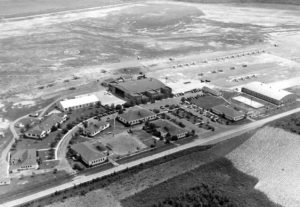 A barracks room. Simple and spartan, but it does the job.
A barracks room. Simple and spartan, but it does the job.
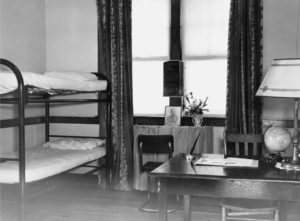 Flying cadets return from training.
Flying cadets return from training.
 From the Archives of Congregation Beth Ahabah in Richmond, Virginia, this image shows Milton Joel standing before a Stearman PT-17, presumably at Tuscaloosa.
From the Archives of Congregation Beth Ahabah in Richmond, Virginia, this image shows Milton Joel standing before a Stearman PT-17, presumably at Tuscaloosa.
Very (very!) close examination of the photograph (it’s actually a paper photocopy, thus accounting for its graininess and low resolution) reveals that the Stearman’s serial number is 40-1841. According to the Aviation Archeology database, this aircraft was involved in a landing accident at Albany Field, Georgia, on October 29, 1941, while piloted by Donald P. Chapman.
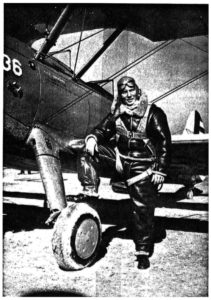 The date of the photograph is unknown, but from crispness of shadows and bright illumination, it was certainly a very sunny day.
The date of the photograph is unknown, but from crispness of shadows and bright illumination, it was certainly a very sunny day.
________________________________________
Having completed his Basic Flying School at Gunter Field, Alabama, in March of 1941, Milton next attended Advanced Flying School at Maxwell Field, Alabama, from which he graduated the following May. Along with six other Aviation Cadets from Virginia, Milton appeared in this Richmond Times-Dispatch photograph on April 27, 1941. Here, the seven cadets and flight instructor Lieutenant Neener stand before a North American AT-6 Texan advanced trainer.
 Caption: YOUNG PILOTS TRAIN – Seven Virginians are shown here checking final flight plans with Lieutenant E.H. Neener at Maxwelll Field, Ala., where they are in training. They are (left to right) Cadets Glassel Stringfellow of Culpepper, Charles R. Mallory Jr. of Richmond, Milton Joel of Richmond, Lieutenant Neener, Cadets George L.J. Newton of Powhatan County, Roy L. Reeve of Arlington, R.L. Tribble of South Boston and Thomas Campbell of Franklin. The cadets will graduate next month with more than 200 hours’ air training at the Advanced Flying Field. They will be commissioned second lieutenants and sent on extended active duty with regular Air Corps units.
Caption: YOUNG PILOTS TRAIN – Seven Virginians are shown here checking final flight plans with Lieutenant E.H. Neener at Maxwelll Field, Ala., where they are in training. They are (left to right) Cadets Glassel Stringfellow of Culpepper, Charles R. Mallory Jr. of Richmond, Milton Joel of Richmond, Lieutenant Neener, Cadets George L.J. Newton of Powhatan County, Roy L. Reeve of Arlington, R.L. Tribble of South Boston and Thomas Campbell of Franklin. The cadets will graduate next month with more than 200 hours’ air training at the Advanced Flying Field. They will be commissioned second lieutenants and sent on extended active duty with regular Air Corps units.
________________________________________
A review of National Archives Records covering Honor Rolls of WW II Army Dead (via the National WW II Memorial website) reveals that all the above (then) Cadets, as well as Lt. Neener, survived the war. Milton was the only member of this group who did not return.
________________________________________
This news item of May 2, 1941 from “The Richmond Daybook” section of the Richmond Times-Dispatch, reports on Milton’s final stages of Advanced Flying Training at Maxwell Field, Alabama.
 FLYING Cadet Milton Joel, son of Mr. and Mrs. Joseph Joel of Greenway Lane, Richmond, has begun the final phases of his flying training at the Air Corps Advanced Flying School, Maxwell Field, Montgomery, Ala. On May 29 he will be graduated into the status of second lieutenant, Air Corps Reserve, receive military aeronautical status of “pilot” and be assigned to extended duty training with a regular squadron for a period of one year. Cadet Joel finished his basic training at Gunter Field, Montgomery, last March.
FLYING Cadet Milton Joel, son of Mr. and Mrs. Joseph Joel of Greenway Lane, Richmond, has begun the final phases of his flying training at the Air Corps Advanced Flying School, Maxwell Field, Montgomery, Ala. On May 29 he will be graduated into the status of second lieutenant, Air Corps Reserve, receive military aeronautical status of “pilot” and be assigned to extended duty training with a regular squadron for a period of one year. Cadet Joel finished his basic training at Gunter Field, Montgomery, last March.
________________________________________
This photographic portrait of Milton as a Flying Cadet, from the United States National Archives’ collection “Photographic Prints of Air Cadets and Officers, Air Crew, and Notables in the History of Aviation”, in NARA Records Group 18-PU. Notation on the photo (not visible in this image) states “Graduated 5/29/41”. This image is only one of the collection’s many thousands of portraits and related photos, which – spanning the very late 1930s through approximately 1944 and having heaviest coverage from 1941 through 1943 – includes a small number of photos from WW I and the twenties, and, a few pictures of foreign aviators from the 20s and 30s. You can read much more about the this collection in Five Pilots in December (which displays images of the five Army Air Corps fighter pilots who lost their lives during the Japanese attack on Pearl Harbor), at my brother blog, ThePastPresented. (Milton’s portrait, serial number “P-8000”, is located in Box 47 of RG 18 PU’s 105 archival storage boxes.)
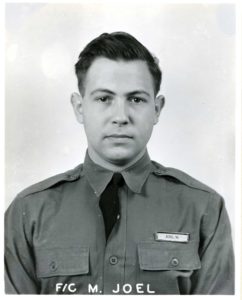 On May 30, 1941, Milton’s high-school newspaper the Jeffersonian reported his graduation from Maxwell Field.
On May 30, 1941, Milton’s high-school newspaper the Jeffersonian reported his graduation from Maxwell Field.
 Flying Cadet Milton Joel ’36, who was business manager at the Jeffersonian in 1935-36, was graduated into the status of second lieutenant, Air Corps Reserve, at the Air Corps Advanced Flying School, Maxwell Field, Montgomery, Ala., yesterday. He also received the military aeronautical status of “pilot” and was assigned to extended active duty training with a regular squadron for a year.
Flying Cadet Milton Joel ’36, who was business manager at the Jeffersonian in 1935-36, was graduated into the status of second lieutenant, Air Corps Reserve, at the Air Corps Advanced Flying School, Maxwell Field, Montgomery, Ala., yesterday. He also received the military aeronautical status of “pilot” and was assigned to extended active duty training with a regular squadron for a year.
A little over a month later, on July 21, the Times-Dispatch reported Milton’s assignment to the 27th Pursuit Squadron of the 1st Pursuit Group, then at Selfridge Army Airfield, Michigan.
Richmond Aviator Goes to Michigan
 SELFRIDGE FIELD, Mich., July 21 – Milton Joel, son of Mr. and Mrs. Joseph Joel, Greenway Lane, Richmond, and recent graduate of the Air Corps Flying School, Maxwell Field, Ala., has been assigned as a second lieutenant with the World War famous First Pursuit Group at Selfridge Field, and has taken over his flying duties with the Twenty-Seventh Pursuit Squadron, Major Robert S. Israel, Jr., commanding officer of the “P-38” Fighter Group, revealed today.
SELFRIDGE FIELD, Mich., July 21 – Milton Joel, son of Mr. and Mrs. Joseph Joel, Greenway Lane, Richmond, and recent graduate of the Air Corps Flying School, Maxwell Field, Ala., has been assigned as a second lieutenant with the World War famous First Pursuit Group at Selfridge Field, and has taken over his flying duties with the Twenty-Seventh Pursuit Squadron, Major Robert S. Israel, Jr., commanding officer of the “P-38” Fighter Group, revealed today.
Joel, who has attended both the University of Virginia and the University of Richmond, is required to accomplish a minimum of fifty hours’ flying monthly.
Beside the regular aerial flights, Joel must undergo intensive ground flying. Key to the paradox is the Link trainer, an ingenious and complex device which makes it possible to simulate the conditions of blind flying.
In November of 1941, Milton’s assignment to the 27th Pursuit Squadron involved participation in the Army’s Carolina Maneuvers, with the 1st Pursuit Group (a component of the 6th Fighter Wing) taking part in all four Maneuver phases: Louisiana Phases 1 and 2, and Carolina phases 1 and 2, from September 15 through 27, and November 16 through 27, respectively.
These two images show Milton standing before a P-38D YP-38 Lightning bearing aircraft-in-squadron number “96”. The aircraft carries temporary (water-based-paint) Maneuver markings, consisting of a red cross upon its nose, and, (rather fading) white paint on the bottom of its gondola and wings. (c/o Sarah F. Markham)
 In this image, the crest of the 1st Fighter Group is visible on Milton’s service cap, while the Army Air Corp’s pre-war “triple-pinwheel” orange and blue emblem is visible on his left shoulder. (c/o Sara F. Markham)
In this image, the crest of the 1st Fighter Group is visible on Milton’s service cap, while the Army Air Corp’s pre-war “triple-pinwheel” orange and blue emblem is visible on his left shoulder. (c/o Sara F. Markham)
Here’s an example of the pre-war art-deco-ish shoulder Army Air Force patch, worn from July 20, 1937, through March 19, 1942, when it was replaced by the more well-known winged star.
Continuing with John Clements’ identification of this plane as a YP-38, here the list of all YP-38s – but one – compiled by Joe Baugher:
MSN 122-2202/2214. Model 122-62-02 service test aircraft.
689 crashed during high-speed dive Nov 4, 1941 over Glendale, CA, killing test pilot Ralph Virden.
690 assigned to NACA Langley Memorial Aeronautical Laboratory, Virginia Nov 27, 1941 to Feb 4, 1942. To Parks Air College, St Louis, MO Feb 26, 1942.
691 assigned to NACA Langley Memorial Aeronautical Laboratory, Virginia Nov 27, 1941. Scrapped at Sacramento Air Depot Dec 17, 1945.
692 scrapped at Lowry Field, Denver, CO Jul 5, 1945.
693 relegated to class CL-26 maintenance trainer at Chanute, AK Jul 24, 1942.
694 relegated to class CL-26 maintenance trainer Jan 5, 1943, Granite Falls, WA.
695 w/o Jul 23, 1941, Alpena, MI.?
697 used as class CL-26 maintenance trainer Jan 5, 1943 at Lockheed
698 scrapped Mar 20, 1946 San Bernardino, CA.
699 crashed Jun 23, 1941, Atlanta, MI. Pilot Lt Guy Leland Putnam killed.
700 relegated to class CL-26 maintenance trainer Jan 27, 1943 at Brookley Field, Mobile, AL.
701 relegated to class CL-26 maintenance trainer Jan 5, 1943 at Lockheed
On discussing the above list, John noted that aircraft “696” is missing. Being that the plane-in-squadron (tail) number of Major Joel’s plane is “96” (as seen in the photo on page 81 of Dana Bell’s Air Force Colors), John suggests that the plane could be the absent “696”, or specifically, “39-696”. Makes sense to me!
The photo below, provided by John, is of, “…the YP that was used in wind tunnel tests in Virginia. It’s the best photo of the engine nacelle of the YP’s that I have found so far.” The front of the nacelle is identical to that of Major Joel’s plane.
Interestingly, Bert Kinzey’s book states that for YP-38, “Armament was to be two .50-caliber machine guns, two .30-caliber machine guns, and a single 37-mm cannon. However, this was not fitted, and the gun ports were faired over.” In that context, perhaps 696’s armament of two machine guns, the muzzles of which are covered with streamlined cylindrical fairings, represents a modification carried out after the plane was assigned to the 1st Fighter Group.
The specific P-38D YP-38 serving as a backdrop to Major Joel can be seen (a very tiny portion of it can be seen) in Army Air Corps Photo “A 20599AC / 342-3B-41009”, dated November 3, 1941: The number on its port fin and rudder is visible immediately to the left of the port fin and rudder of P-38 “67”, the latter in the right center of the image. This picture can be found on page 81 of Dana Bell’s Air Force Colors, Vol. I.
Another photo provided by John: 1st Fighter Group P-38s – #54 and #51 – at the Carolina Maneuvers.
From Air Force Colors, Vol. I, here’s an illustration of a P-38D in “red force” markings:
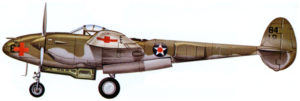 ________________________________________
________________________________________
Two images of Milton in the United States. Date unknown; location unknown.
(c/o Ida Joel Kaplan)
 ________________________________________
________________________________________
While assigned to the 27th Fighter Squadron, Milton was promoted to 1st Lieutenant in February or March of 1942, and then Captain in June. It was at the latter rank that on October 3, 1942, he took command of the 38th Fighter Squadron at Paine Field, Washington. This photo, showing Milton wearing a flight jacket with the insignia of the 27th Fighter Squadron, can therefore be dated as having been taken before that date. (c/o Harold Winston)
 ________________________________________
________________________________________
The circumstances – random luck? – a mutual acquaintance? – by which Milton and his future wife, Elaine Ebenstein of Beverly Hills, California, met one another, are unknown. However, most definitely known is that they were married at Paine Field in June of 1943, as reported in the Richmond Times-Disptach on June 25, of that year.
 Miss Ebenstein Will Marry Major Milton Joel, USAAF
Miss Ebenstein Will Marry Major Milton Joel, USAAF
Mr. and Mrs. Herbert R. Ebenstein, of New York and Beverley Hills, Calif., announce the engagement of their daughter, Elaine, to Major Milton Joel, United States Army Air Force, son of Mr. and Mrs. Joseph Joel, of Richmond.
The wedding will take place June 29 [Tuesday] at Paine Field, Everette, Wash.
The groom is a graduate of the University of Richmond in the class of 1940.
Characterized by her friend Sarah Markham as “tall, thin, and regal”, here is Elaine’s portrait. (c/o Harold Winston)…
 …and, here’s a view of Minnie, Joseph, and their beaming daughter-in-law in Richmond. (c/o Ida Joel Kaplan)
…and, here’s a view of Minnie, Joseph, and their beaming daughter-in-law in Richmond. (c/o Ida Joel Kaplan)
 Next: Part III – On Course
Next: Part III – On Course
1,507 – November 12, 2020



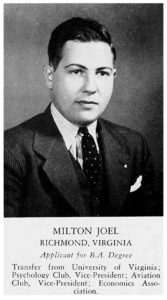
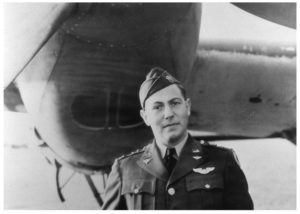

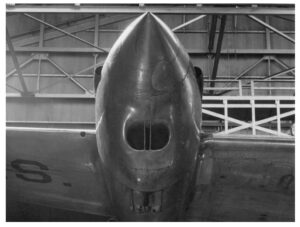
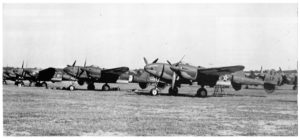

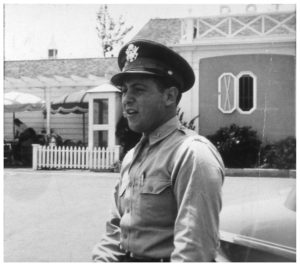
Maj. Milton Joel was my cousin (my dad’s contemporary, although eight years Pop’s senior). When Pop (now 96 y.o. and going strong) was in the U.S. Army of Occupation in Germany (1945-47), he spent a lot of time trying to track down cousin Milton’s remains, but was unsuccessful. Cousin Milton called my Pop “Little Buddy” and Pop loved and revered him. The Joels, Weinstein’s and the Rubin families were all heart broken over the loss of Milton. By all accounts he was a warm, kind and witty man.